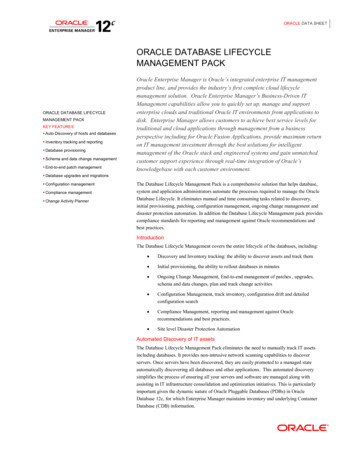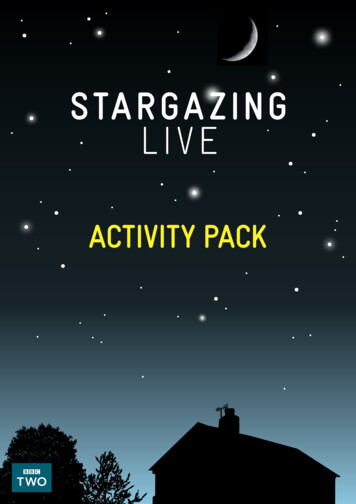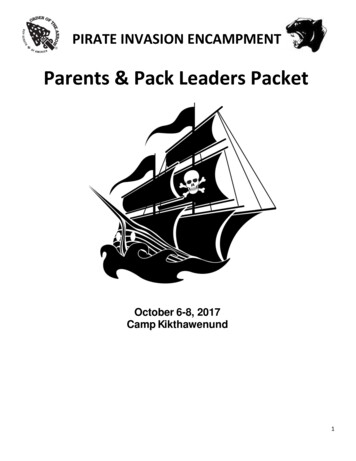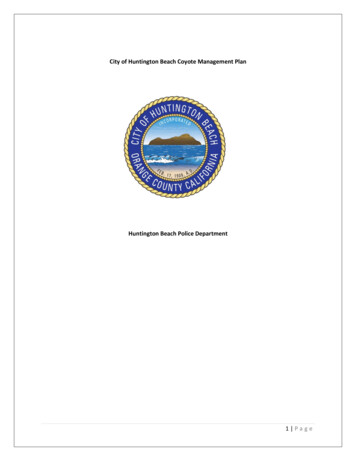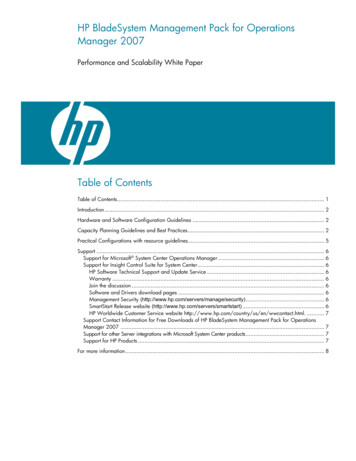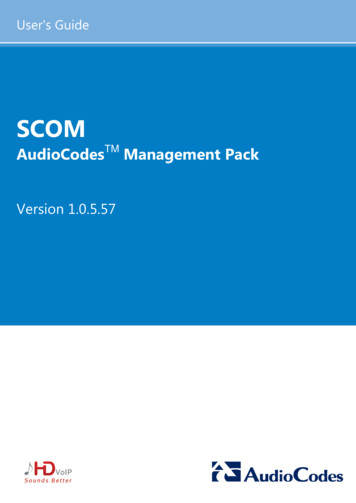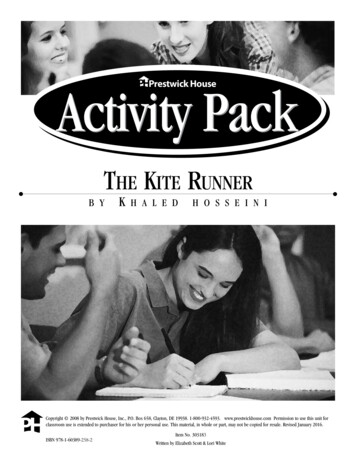
Transcription
Prestwick HousePrestwick HouseActivity PackThe Kite Runnerb yKh a l e dh o s s e i n iCopyright 2008 by Prestwick House, Inc., P.O. Box 658, Clayton, DE 19938. 1-800-932-4593. www.prestwickhouse.com Permission to use this unit forclassroom use is extended to purchaser for his or her personal use. This material, in whole or part, may not be copied for resale. Revised January 2016.ISBN 978-1-60389-258-2Item No. 303183Written by Elizabeth Scott & Lori White
Student’s Page Name:The Kite RunnerDate:Chapters 1 and 2Point of View and ToneObjective: Recognizing and working with point of view and narrative toneActivityThe point of view from which a story is told makes a big difference in how it is told. In a first-personnarrative, we are receiving the impressions of one only of the characters, and that character’s impressionswill be colored by his or her age, gender, beliefs, and so on. First-person narratives are always limited tothis single character’s perspective. In a third-person limited narrative, the story is told from the perspectiveof a single character, but in the third-person voice as opposed to the first person voice. In a third-personomniscient narrative, the narrator is not limited to the perspective of a single character. The narrator nowhas access to the thoughts and feelings of all characters in the narrative—he has omniscience.It is important to keep in mind that nothing is accidental in writing. Authors choose their words,punctuation, and structure of the language with deliberate care to convey just the appropriate tone andmessage.A. Read the below passages and fill in the chart that follows, providing both the point of view andthe tone of each passage. If the narrative is in the third-person, make sure to mention whether it islimited or omniscient.Selection 1:You don’t know about me, without you have read a book by the name of “The Adventures of Tom Sawyer,”but that ain’t no matter. That book was made by Mr. Mark Twain, and he told the truth, mainly. There wasthings which he stretched, but mainly he told the truth. That is nothing. I never seen anybody but lied, onetime or another, without it was Aunt Polly, or the widow, or maybe Mary. Aunt Polly–Tom’s Aunt Polly, sheis–and Mary, and the Widow Douglas, is all told about in that book–which is mostly a true book; with somestretchers, as I said before.Selection 2:His tale had occupied the whole day, and the sun was upon the verge of the horizon when he departed. I knewthat I ought to hasten my descent towards the valley, as I should soon be encompassed in darkness; but myheart was heavy, and my steps slow. The labour of winding among the little paths of the mountain and fixingmy feet firmly as I advanced perplexed me, occupied as I was by the emotions which the occurrences of theday had produced. Night was far advanced when I came to the half-way resting-place and seated myself besidethe fountain. The stars shone at intervals, as the clouds passed over them; the dark pines rose before me, andevery here and there a broken tree lay on the ground: it was a scene of wonderful solemnity and stirred strangethoughts within me. I wept bitterly; and clasping my hands in agony, I exclaimed, “Oh! Stars and cloudsand winds, ye are all about to mock me: if ye really pity me, crush sensation and memory; let me become asnought; but if not depart, depart, and leave me in darkness.S - 13Reproducible Student Worksheet
Student’s Page Name:The Kite RunnerDate:Chapter 3Baba’s ViewObjective: Extending ideas from the textActivity1. Baba has very strict views on life, particularly regarding sin. According to Baba, “ there is only onesin, only one. And that is theft. Every other sin is a variation of theft.” What does he mean by this?2. Research the seven cardinal sins and/or the Ten Commandments and list your findings below. Usingone or the other as a guide, apply Baba’s “one sin” premise. Does it hold up? Explain—why or whynot?3. Why does Amir inwardly struggle with Baba’s statement that there is only one sin? If you were Amir’sfriend, what would you tell him?List of Seven Cardinal Sins/Ten Commandments:1.2.3.4.5.6.7.8.9.10.S - 19Reproducible Student Worksheet
Student’s Page Name:The Kite RunnerDate:Chapter 4“I Am” PoemObjective: Understanding character motivationSynthesizing character traitsActivityWrite an “I am” poem for one of the characters. Draw your information from the character’s words andactions in the novel. You may choose to use direct quotations where appropriate.Line 1: Begin with the words “I am.”Line 2: Write three nouns about which your character has strong feelings.Line 3: Write a complete sentence about two things your character likes.Line 4: Begin with three nouns that describe qualities your character appreciates in other people.End the sentence with the words “are important to me.”Line 5: Write a sentence explaining something positive your character likes about himself orherself.Lines 6 & 7: Begin a sentence in line 6 in which you show something negative your character sees inhimself/herself or in others; finish the sentence in line 7 by showing that out of somethingbad can come good. Use the word “but” or “however” to link the two ideas.Lines 8, 9, 10: Write three short sentences explaining things about which your character has strongfeelings – likes or dislikes. These do not have to relate to each other or to the previouslines you have written.Line 11: End the poem with the words, “I am .” (Fill in the name of the character youhave chosen.)Example:1234567891011I amRain, Forests, and Sunsets.I like long walks and quiet times.Honesty, Humor, and Peace are important to me.I find satisfaction in a job well done.I can be fearsome when my ideas are challenged,But I thrive on intelligent conversation.I love nature and animals.I can be counted on to help.I have strong feelings when a life is threatened.I am .S - 21Reproducible Student Worksheet
Student’s Page Name:The Kite RunnerDate:Chapter 5Diary EntryObjective: Understanding historical referencesWriting a diary entryActivityIn Chapter Five, Hassan and Amir are startled by the sound of explosions, gunfire, and sirens that beginthe 1973 “bloodless coup” of Afghanistan. Imagine that you are a reporter in the midst of this situation,covering it for a story. Write a diary entry on the coup and the end of the Afghan monarchy from theperspective of someone who might have been there in 1973; the knowledge of, obviously, would haveno the present time. How might this person have felt during this uncertain time? What might he havepredicted happening in the future?S - 23Reproducible Student Worksheet
Student’s Page Name:The Kite RunnerDate:Chapter 6ImageryObjective: Identifying imageryUsing imagery in writingIn the first part of Chapter Six, Amir uses imagery, writing that appeals to one or more of the five senses,to relate several reasons why winter is his favorite season.Here is what I do on the first day of snowfall every year: I step out of the house early in the morning, still inmy pajamas, hugging my arms against the chill. I find the driveway, my father’s car, the walls, the trees, therooftops, and the hills buried under a foot of snow. I smile. The sky is seamless and blue, the snow so whitemy eyes burn. I shovel a handful of the fresh snow into my mouth, listen to the muffled stillness broken onlyby the cawing of crows. I walk down the front steps, barefoot, and call for Hassan to come out and see.then I slipped back into bed in my flannel pajamas. I pulled the blanket to my chin and watched thesnowcapped hills in the north through the window. Watched them until I drifted back to sleep.I loved wintertime in Kabul. I loved it for the soft pattering of snow against my window at night, for the wayfresh snow crunched under my black rubber boots, for the warmth of the cast iron stove as the wind screechedthrough the yards, the streets. But mostly because, as the trees froze and ice sheathed the roads, the chillbetween Baba and me thawed a little.ActivityPart One:In the chart that follows, identify five examples of imagery from the paragraphs above and explain whichof the senses each one appeals to. For example, “hugging my arms against the chill” appeals to the senseof touch.IMAGERY CHARTExample of ImagerySenseS - 25Reproducible Student Worksheet
Student’s Page Name:The Kite RunnerDate:Chapter 7DialogueObjective: Demonstrating familiarity with characters’ voices through writing dialogueActivityWe often learn as much about characters from their conversations as we do from their actions. Thisactivity will enable you to demonstrate your knowledge of The Kite Runner’s characters and to exerciseyour imagination.Choose any of these prompts and for each, write at least a page of dialogue that might have occurred inthe situation mentioned. Feel free to let the dialogue carry you beyond what you already know of thecharacters, but strive to represent them accurately.1. Write a conversation between Baba and Rahim Khan as they watch the kite-fightingtournament.2. Imagine that either Amir or Hassan speak of the rape. Write the conversation that might happenbetween them.3. Imagine that Amir confronts Assef before he attacks Hassan. Write the conversation between thecharacters.4. Write a conversation between Amir and Baba about Amir’s victory.S - 29Reproducible Student Worksheet
Student’s Page Name:The Kite RunnerDate:Chapter 8Character AssessmentObjective: Synthesizing details about characters in order to understand themActivityThroughout The Kite Runner, Hosseini has been providing details about Amir and Hassan. These detailshave been given both in the form of direct characterization and indirect characterization.We are told early in the novel that Hassan is harelipped (Chapter One), that “polio had left Ali with atwisted, atrophied right leg that was sallow skin over bone,” (Chapter Two), and that the narrator, Amir,“aspire[s] to cowardice” (Chapter Seven). Direct characterization is when the narrator directly providesinformation about a character to the reader.In indirect characterization, a character’s traits are revealed through his words, actions, thoughts, andthrough what others say about him and how they respond to him. Study this example from ChapterFour:My favorite part of reading to Hassan was when we came across a big word that he didn’t know.I’d tease him, expose his ignorance. One time, I was reading him a Mullah Nasruddin story and hestopped me. “What does that word mean?”“Which one?”“Imbecile.”“You don’t know what it means?” I said, grinning.“Nay, Amir agha.”“But it’s such a common word!”“Still, I don’t know it.” If he felt the sting of my tease, his smiling face didn’t show it.“Well, everyone in my school knows what it means,” I said. “Let’s see. ‘Imbecile.’ It means smart, intelligent.I’ll use it in a sentence for you. ‘When it comes to work, Hassan is an imbecile.’”This passage reveals Amir’s need to set himself up as a higher authority at the expense of the naïve andignorant Hassan. Amir ridicules him because knowing that Hassan does not really understand the mockerymakes Amir feel better about himself. This insight into Amir’s personality is revealed indirectly throughhis words and actions toward Hassan, rather than through the narrator saying, “I liked to ridicule Hassanbecause it made me feel better about myself.” You can see why indirect characterization is generallyconsidered to be a much more powerful means of communicating information about a character than thedirect method.Chapter Eight contains many examples of indirect characterization for both Amir and Hassan. In the spaceprovided, write down several examples of indirect characterization and explain what each reveals aboutthe character. If the example is long, as the one you just read, feel free it. One has been done for you as anexample.S - 31Reproducible Student Worksheet
Student’s Page Name:The Kite RunnerDate:Chapter 9CollageObjective: Identifying with a characterAt the beginning of Chapter Nine, Amir opens his birthday presents without excitement and tosses theminto a corner of his room. He is unable to take any joy in them or to celebrate their occasion, knowingthat “it was all blood money; Baba would never have thrown [him] a party like that if [he] hadn’t won thetournament.” He feels the weight of responsibility for leaving Hassan to his fate instead of stepping in andtrying to help and feels that all of the birthday presents and birthday celebration are at Hassan’s expense.ActivityMake a collage of items, events, or ideas that make you feel a sense of guilt. If you have difficulty findingpictures for abstract ideas, consider making simple sketches or even typing words on the computer usinginteresting fonts and backgrounds and then printing them.S - 35Reproducible Student Worksheet
Student’s Page Name:The Kite RunnerDate:Chapter 10News ArticleObjective: Writing about key eventsA great deal happens in Chapter Ten. Amir and Baba become refugees and go to Pakistan. Amir learns thatKamal, a former tormentor of Hassan, has suffered the same fate as Hassan. Baba prevents another rape,this of a young mother, from occurring, demonstrating his courage and conviction. Kamal becomes a fatalvictim to the journey to Pakistan when inhaling the toxic fumes from within the fuel truck kills him.ActivityDirections: Pretend you are a reporter and you have been given the task of writing an article about one ofthese events. Keep in mind the following aspects of news articles: news article provides key information about a recent event. It should answer “Who?” “What?”A“When?” “Where?” “Why?” and “How?” ost news articles are told in the inverted pyramid form. An inverted pyramid story beginsMwith the most important information in the first paragraph and ends with the least importantinformation in the last paragraph(s). he first paragraph should begin with a strong “lead,” a compelling sentence that grabs theTreader’s attention and gives them a reason to keep reading. aragraphs in a news article should be short and full of information. Imagine them in print.PPeople reading a newspaper do not want to read huge blocks of dense text; rather, then wouldneed to have the text broken up into smaller segments to provide some visual relief.With these tips in mind, write the news story.S - 37Reproducible Student Worksheet
Feel free to let the dialogue carry you beyond what you already know of the characters, but strive to represent them accurately. 1.Write a conversation between Baba and Rahim Khan as they watch the kite-fighting tournament. 2. Imagine that either Amir or Hassan speak of the rape. Write the conversation that might happen between them. 3. Imagine that Amir confronts Assef before he attacks .

